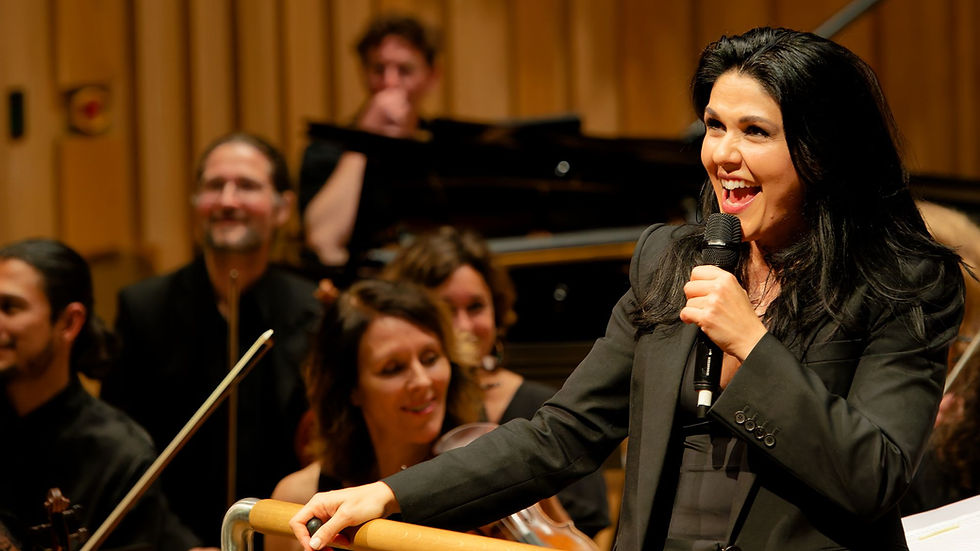Review: Another Seven Symphonies at the Tung Auditorium ****
- Catherine Jones
- Jul 21, 2025
- 4 min read

If you’re going to stage a Beatles world premiere, there’s only one place you really want to do it.
And Liverpool rolled out rousing reception on a sticky July evening for the Antwerp Philharmonic, in the city where it all began to give the first live performance of Another Seven Symphonies.
At the risk of confusion, don’t worry, there aren’t seven other Beatles’ symphonies that Fab Four fans have somehow missed.
Four years ago, when the Antwerp Phil and its effervescent Brazilian conductor Alexandra Arrieche premiered the original Seven Symphonies, the piece brought together not Beatles but nearly three dozen Beach Boys tunes in (doing what it says on the tin) seven orchestral works.
The American group’s lush, radiant vocal harmonies are almost crying out to be orchestrated, and that’s exactly what Rob van Weelde and Roeland Jacobs of Dutch recording outfit WedgeView Studios did in a homage to the melodies of Brian Wilson and co.
It was buoyed by that success that they turned their attention to the biggest band in the world.
And it feels like a natural follow up, not only because the Beatles and Beach Boys drove each other on to scale the heights of creativity (Rubber Soul heavily influenced Pet Sounds, and in turn the innovative Pet Sounds informed the making of Sgt Pepper), but because much of the Beatles’ output, certainly from 1964 onwards, featured arrangements for strings, wind and brass instruments.
Ask most people and they might mention the string quartet on Yesterday, the stabbing strings of Eleanor Rigby, the winds and brass that populate Penny Lane or, of course, the mad cacophonous 24-bar spiral of A Day in the Life.
But those are just the tip of a Titanic-sized iceberg. And of the 39 songs chosen for Another Seven Symphonies – and woven thoughtfully together in thematic fashion by Jacobs, around three quarters of the originals already included orchestration, experimental keyboards (harmonium, Moog synth, organ, clavichord or electric harpsichord) or interesting percussion choices.
So composer and arranger Jacobs was pushing at an open door left ajar by the band and by the late, great Sir George Martin.
Of course, this is both a blessing and a curse/challenge. How do you remain true to the Lennon/McCartney/Harrison vision while creating your own distinct sound world at the same time?
Jacobs neatly sidesteps the most obvious: there’s just the briefest hint of A Day in the Life in the second piece, titled Abbey Symphony and built around the burnished melodies of the 1969 album's second side, while in the final symphony he turns the poignant Eleanor Rigby into an off-kilter dance that has shades of Waltz II from Shostakovich’s Suite for Variety Orchestra.

Above: Conductor Alexandra Arrieche introduces the music. Top: The Antwerp Philharmonic at the Tung Auditorium. Photos by Alan Blundell Photography.
A large body of musicians in an intimate space like the Tung Auditorium meant the opening Symphony of the Walrus (Dear Prudence, Strawberry Fields and Glass Onion among the melodies) became something of a sonic assault.
But amid the wall of sound there was a lovely Gershwin-esque swagger introduced by muted trumpet on the Walrus line ‘I’m crying’, and the start of a busy night for xylophone (in fact, all the percussion) as the piece modulated from Strawberry Fields through a hint of Glass Onion and Day Tripper to arrive at Lennon’s sly nod to Edgar Allan Poe.
Elsewhere, the oft overlooked George Harrison got a symphony all to himself which opened with Here Comes the Sun and concluded with the exquisite Something. In between the orchestral part warps and wefts between If I Needed Someone, underscored by an engine room of winds and harp, and You Like Me Too Much, which seems to be a slightly strange option when you also potentially have the run of his entire Beatle catalogue including luscious melodic sweep of I Me Mine.
It was followed by own favourite of the night, the Symphony of Jazz.
McCartney’s storytelling lends itself particularly well to orchestral treatment (She’s Leaving Home, Eleanor Rigby). But it’s his catholic range of musical influences which is celebrated in the symphony, with the Antwerp Phil evidently enjoying the chance to turn jazz band.
There was a trumpet vocal line over pizzicato strings of Your Mother Should Know, before Fixing a Hole arrived in a jaunty oboe solo which slipped seamlessly into Martha My Dear, bounced between winds and brass, and a Cotton Club-like Honey Pie giving way, if only briefly, to When I’m 64 (if performed by Wilson, Keppel and Betty).

Above: The score for the All Our Loving Symphony. Photo by Alan Blundell Photography.
The three remaining symphonies came after the interval.
McCartney's output dominated All Our Loving, with a lovely trumpet vocal line running above some plush orchestration as far as Yesterday, where clarinet and flute shared the melody, while there was a late appearance for Lennon and his plangent If I Fell.
A trumpet duo evoked John and Paul’s close harmonising in Symphony of the Hill, which mixed and matched a series of songs from the front end of the Beatle timeline (plus a burst of Piggies complete with harp glissando and baroque harpsichord) – but which, as with one or two of the other symphonic works, finished somewhat abruptly.
And the seventh symphony, Rigby’s Waltz, arrived with celeste picking out the hallucinatory opening of Lucy in the Sky With Diamonds and continued on a psychedelic journey to a final Goodnight.
Not quite goodnight however - with Arrieche and orchestra pulling a post-Beatles encore from their back pocket, segueing from Band on the Run via the inevitable Imagine to the beatific My Sweet Lord. Sweet indeed.







